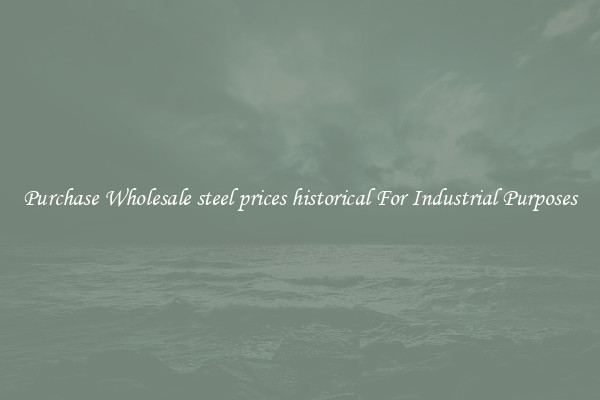Purchase Wholesale steel prices historical For Industrial Purposes
Wholesale steel prices have always played a significant role in the industrial sector. Historically, these prices have been closely monitored and analyzed by businesses involved in manufacturing, construction, infrastructure development, and other industrial activities. Understanding the historical trends of wholesale steel prices is crucial for making informed decisions when it comes to purchasing this essential raw material.

The industrial sector heavily relies on steel for its strength, durability, and versatility. From building structures and machinery to manufacturing automobiles and infrastructure projects, steel is the backbone of numerous industries worldwide. As a result, the fluctuations in wholesale steel prices have a direct impact on the profitability and competitiveness of businesses within these sectors.
Analyzing the historical trends in wholesale steel prices provides valuable insights into the market's behavior, enabling businesses to effectively plan their procurement strategies and manage their production costs. By studying the historical data, companies can identify patterns, cycles, and factors that influence steel prices, such as global demand, supply chain disruptions, trade policies, and economic conditions. These findings can help them make accurate forecasts and anticipate future price movements, allowing for better budgeting and decision-making.
Historical data can also aid businesses in negotiating favorable pricing contracts with suppliers. Armed with knowledge of how steel prices have fluctuated over time, industrial buyers can better engage in negotiations and secure deals that align with their budgetary requirements. Moreover, businesses can use historical data to assess the impact of potential price changes on their inventory and adjust their pricing strategies accordingly.
Furthermore, studying historical wholesale steel prices allows industrial businesses to compare and benchmark their purchasing costs against industry standards. This analysis enables them to identify opportunities for cost-saving measures, optimize their procurement protocols, and remain competitive in the market.
In recent years, trends in wholesale steel prices have become increasingly dynamic due to factors such as geopolitical tensions, trade wars, and the onset of the COVID-19 pandemic. Historical data offers a comprehensive view of how the market has responded to these challenges in the past, allowing businesses to develop resilience plans and mitigate potential risks.
In conclusion, understanding the historical trends in wholesale steel prices is crucial for industrial businesses. Analyzing this data provides valuable insights into market behavior, helps in negotiating better pricing contracts, allows for cost-saving measures, and aids in building resilience against market fluctuations. By staying informed about historical wholesale steel prices, businesses can make informed decisions that positively impact their bottom line and ensure sustainable growth in the industrial sector.

View details

View details

View details

View details








